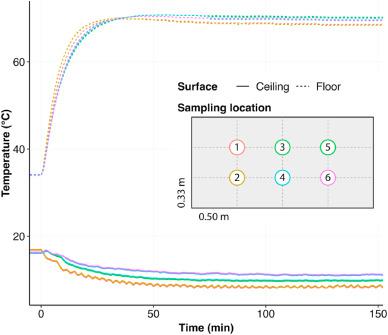当前位置:
X-MOL 学术
›
Build. Environ.
›
论文详情
Our official English website, www.x-mol.net, welcomes your feedback! (Note: you will need to create a separate account there.)
PIV experimental study on natural convective flows at high Rayleigh numbers in industrial buildings
Building and Environment ( IF 7.4 ) Pub Date : 2024-03-28 , DOI: 10.1016/j.buildenv.2024.111460 Jinyu Liu , Junjie Liu , Jiayu Li
Building and Environment ( IF 7.4 ) Pub Date : 2024-03-28 , DOI: 10.1016/j.buildenv.2024.111460 Jinyu Liu , Junjie Liu , Jiayu Li

|
High heat loads in industrial buildings potentially form strong natural convective flows. These flows exhibit significant unsteadiness and anisotropy, which can profoundly impact indoor air distribution. To study the flow characteristics of thermal convective flows in large indoor spaces, we built a large-scale test bench with controllable thermal boundaries. Under three different heat source intensities represented by Rayleigh numbers (Ra = 3 × 10, 6 × 10, and 1 × 10) that are typical in industrial buildings, we used 2-dimensional particle image velocimetry to capture the large-scale convective airflow by splicing nine subregions, each with 800 instantaneous flow fields sampled at a frequency of 3 Hz. The results show that the convective airflow exhibited large-scale circulation patterns. The velocity near the wall gradually increased with the increased Ra number, while the velocity at the center remained low. The turbulence intensity near the wall was less than 1, while that at the center was larger than 5 and fluctuated greatly. The dominant fluctuation frequency of the airflow under the high Ra was 0.1 Hz. Through proper orthogonal decomposition, it is found that even for horizontal flows, the main transient fluctuations still exhibit an up-and-down fluctuating flow structure. Additionally, the calculation of the velocity structure function revealed that the airflow near the wall is anisotropic, while the airflow at the center is isotropic. The Reynolds number of the flow generated by vertical temperature differences exhibits a power function relationship with the Rayleigh number. This study provides a basis for the optimization of air distribution design in industrial buildings.
中文翻译:

工业建筑高瑞利数自然对流PIV实验研究
工业建筑中的高热负荷可能会形成强烈的自然对流。这些流动表现出显着的不稳定性和各向异性,这会深刻影响室内空气分布。为了研究大型室内空间热对流的流动特性,我们建造了一个具有可控热边界的大型测试台。在工业建筑中常见的以瑞利数(Ra = 3 × 10、6 × 10和1 × 10)表示的三种不同热源强度下,我们使用二维粒子图像测速技术来捕获大范围对流气流:拼接九个子区域,每个子区域有 800 个以 3 Hz 频率采样的瞬时流场。结果表明,对流气流呈现出大范围的环流模式。随着Ra数的增加,靠近壁面的速度逐渐增加,而中心的速度仍然较低。近壁面湍流强度小于1,而中心处湍流强度大于5且波动较大。高Ra下气流的主导波动频率为0.1 Hz。通过适当的正交分解发现,即使对于水平流,主要的瞬态脉动仍然呈现出上下脉动流结构。此外,速度结构函数的计算表明,靠近壁面的气流是各向异性的,而中心的气流是各向同性的。由垂直温差产生的流动的雷诺数与瑞利数呈现幂函数关系。本研究为工业建筑气流组织设计优化提供依据。
更新日期:2024-03-28
中文翻译:

工业建筑高瑞利数自然对流PIV实验研究
工业建筑中的高热负荷可能会形成强烈的自然对流。这些流动表现出显着的不稳定性和各向异性,这会深刻影响室内空气分布。为了研究大型室内空间热对流的流动特性,我们建造了一个具有可控热边界的大型测试台。在工业建筑中常见的以瑞利数(Ra = 3 × 10、6 × 10和1 × 10)表示的三种不同热源强度下,我们使用二维粒子图像测速技术来捕获大范围对流气流:拼接九个子区域,每个子区域有 800 个以 3 Hz 频率采样的瞬时流场。结果表明,对流气流呈现出大范围的环流模式。随着Ra数的增加,靠近壁面的速度逐渐增加,而中心的速度仍然较低。近壁面湍流强度小于1,而中心处湍流强度大于5且波动较大。高Ra下气流的主导波动频率为0.1 Hz。通过适当的正交分解发现,即使对于水平流,主要的瞬态脉动仍然呈现出上下脉动流结构。此外,速度结构函数的计算表明,靠近壁面的气流是各向异性的,而中心的气流是各向同性的。由垂直温差产生的流动的雷诺数与瑞利数呈现幂函数关系。本研究为工业建筑气流组织设计优化提供依据。



























 京公网安备 11010802027423号
京公网安备 11010802027423号